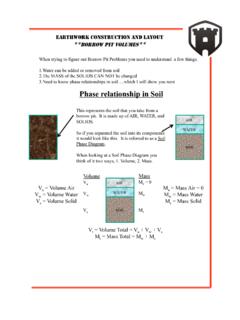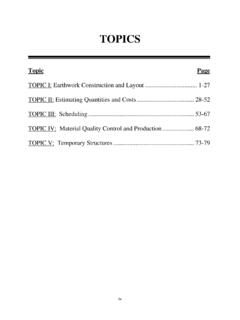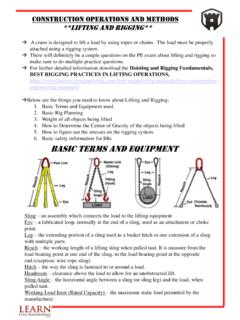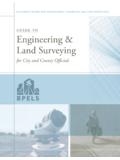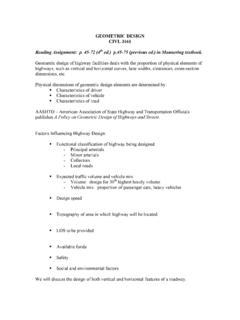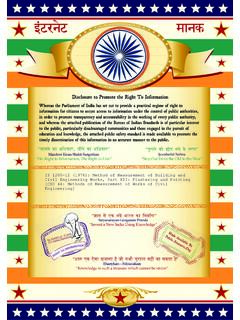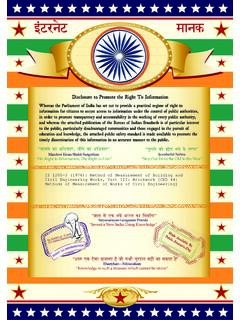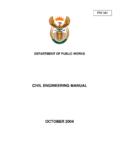Transcription of Materials Soil classification - Learn Civil Engineering
1 ClassificationReferences: 1. Holtz, Robert, D., Kovacs, Williams, D. An Introduction to Geotechnical Engineering . Englewoods Cliffs, New Jersey; Prentice-Hall, Schroeder, , Dickenson, , Warrington, Don, C. Soils in Construction. Fifth Edition. Upper Saddle River, New Jersey; Prentice Hall, of soil classification :Reason for classification : Soil classification is like a language between engineers. The known soil classification communicates their probable Engineering behavior, and allows engineers access to the accumulated experience of other engineers. Soil classification does not remove the need for detailed soil investigations or testing of the soil, but it gives the engineer the general behavior of the Unified Soil classification System (USCS) and the American association of State Highway and Transportation Officials (AASHTO) system are the common classification system we use in Civil Engineering practice.
2 Learning objectives: of soil classification to classify soil using the Unified Soil classification System (USCS) to classify soil using the American association of State Highway and Transportation Officials (AASHTO) to classify soil using US Department of the most likely problems on the PE exploration and samplingSoil classification -USCS Developed by Professor A. Casagrande in 1948 for airfield construction during World War II, and modified in 1952 for the US Bureau of Reclamation and US Army Corps of Engineers to make the system applicable to dams, foundations, and other construction. The basis concept is soils in which the fines do not affect the Engineering performance are classified according to their grain size characteristics, and soils in which fines do control the Engineering behavior are classified according to their plasticity characteristics. Only a sieve analysis and Atterberg limits are required to completely classify the soil using USCS.
3 The four major divisions of soil are 1. course-grained2. fine-grained3. organic soils 4. Peat The highly organic soils and peat can be identified visually. The Course grained soils are those having more than 50% of soil being retained on the No. 200 sieve. Fine grained soils are those that allow more than 50% to pass through the No. 200 sieve. Gravel fraction = percent retained on the number 4 sieve = R4 Sand fraction = percent passing through the number 200 sieve = F200 The Course grained soils are then divided into Gravel (R4> 50)and Sand (R<= 50) are then divided into four secondary groups, GW and SW(<5% passing the No. 200 sieve), GP and SP (little or no nonplastic fines), GM and SM, GC and SC. This depends on the grain size distribution and nature of fines in the soils. exploration and samplingSoil classification Well-graded (W) has good distribution of all particle sizes. Poorly graded (P) could be uniform or skip a size.
4 You figure out if the soil is well graded or not by the Coefficient of uniformity (Cu) and the Coefficient of Curvature (Cc ). Cu= D60/ D10 Cc= D230/ ( D10x D60)D60= grain diameter at 60 % passingD30= grain diameter at 30 % passingD10 = grain diameter at 10% passing by weight The fine grained soils ( > 50% passing the No. 200) are subdivided in silts (M) and clays(C). These are determined by the liquid limit and plasticity index. Plasticity Index (PI) = Liquid Limit (LL) Plastic Limit (PL) Fine-grained soils are silts (M) if their liquid limits and plasticity indices plot below the A-line on Casagrande s plasticity chart. The Fines are clay(C) if the Liquid Limit and PI plot above the A-line. A-line separate the claylike material from those that are silty and the organics from the inorganics. The exception to this rule is organic clays (OL and OH) which plot below the A-line and behave similarly to soils of lower plasticity.
5 L = low plasticity (liquid limit less than 50) H = high plasticity (liquid limit more than 50) exploration and samplingSoil classificationUse these following two charts and the formulas on the previous page to easily classify the soil in accordance with USCS. exploration and samplingSoil #1: The laboratory gradation analyses and Atterberg Limits were performed on two soil samples. Results are summarized below. During testing no organic odor or Materials were noted in either # , , , , SMSubsurface exploration and samplingSoil classificationSoil Sieve SizePercent PassingNo. 4 100No. 1091No. 4083No. 200 51liquid limit (LL) = 35%plastic limit (PL) = 22%Soil Sieve SizePercent PassingNo. 4 80No. 10 72No. 40 35No. 200 20liquid limit (LL) = 37%plastic limit (PL) = 20%1a)What is the classification of Soil A according to the Unified Soil classification System?1b)What is the classification of Soil B according to the Unified Soil classification System?
6 #1: a = CL, SCEasiest Way is to use the Use USCS chartStep 1: Classify Soil A: use the USCS Flow chart to find classification : Since 51% passing #200 sieve that is > 50 Fine-grained soil LL is 35 which is < 50 follow the top row of chart no organic odor or color follow the inorganic Find PI ; PI = LL PL = 35 22 = 13 so PI> 7 and plots above the A line. So Soil A is classified as CL (Lean Clay)Step 2: Classify Soil B: use the USCS Flow chart to find classification : Since only 20% passes #200, more than 50 % retained Course-grained soils 80% passing #4 which is > 50 Sands 20 % passing #200 ( , % fines) > 12% Sands with fines Plot on the plasticity chart to classify -LL =37, PL = 20: PI = 17 falls above the A line in the region CL So Soil B is classified as SC (Clayey Sand)Subsurface exploration and samplingSoil exploration and samplingSoil classification -AASHTO The American association of State Highway and Transportation Officials(AASHTO) and the Federal Highway Administration (FHWA) use the classification system to indicate the behavior of Materials used as highway sub-grades.
7 The AASHTO System uses seven basic soil groups designated A-1 through A-7, the soil is placed in the groups by performance characteristics. A-1 is the best and A-7 is the worst. A-1 to A-3 are sands and gravels, A-4 to A-7 are silts and clays. There is a A-8 which is reserved for unusable peat. The following is the chart to use to find the designated soil exploration and samplingSoil classification -AASHTO The American association of State Highway and Transportation Officials(AASHTO) and the Federal Highway Administration (FHWA) use the classification system to indicate the behavior of Materials used as highway sub-grades. The AASHTO System uses seven basic soil groups designated A-1 through A-7, the soil is placed in the groups by performance characteristics. A-1 is the best and A-7 is the worst. A-1 to A-3 are sands and gravels, A-4 to A-7 are silts and clays. There is a A-8 which is reserved for unusable chart is used for basic identification of soil using US Department of Agriculture.
8 To read the chart you use the following convention. Clay is read straight across to the right, sand is up and to the left and silt is down and to the left. Example: The USDA soil classification of 60% clay, 20% sand and 20% silt is?Answer: ClaySubsurface exploration and samplingSoil classification -USDA



